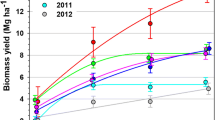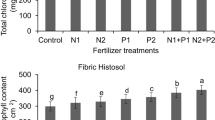Abstract
Common ragweed is an important annual weed in crop production, and is also considered to be a serious public health problem. Determination of common ragweed growth under various nitrogen (N) rate and plant density could aid the development of an integrated control program. Greenhouse and field experiments were conducted to determine the effects of N fertilizer and density on common ragweed growth and seed production. In the greenhouse study, the greatest shoot dry matter (SDM) plant−1 was obtained with the 50 and 100 kg N ha−1. In the field experiment, SDM plant−1 in the low density plots responded favorably to the addition of medium and high levels of N compared to the field level of N. With increasing density, ragweed in higher density plots responded only with the highest N rate. The intensity of intraspecific competition increased with increasing density, thus total SDM plant−1 was significantly reduced, regardless of N rate. Intraspecific competition also reduced the reproductive production of common ragweed where seed production decreased as plant density increased. Plants grown at higher density produced less seeds per plant basis; however, they produced a considerable number of seed on a per area land basis, which is important for the survival of the species and further expansion in agricultural land and non-crop areas. Common ragweed is a fast-growing species, capable of producing considerable biomass and seed at various pure stand densities and N rates. It also justifies the need for early season control to prevent seed production.






Similar content being viewed by others
References
Aguiar MR, Lauenroth WK, Peters DP (2001) Intensity of intra- and interspecific competition in coexisting shortgrass species. J Ecol 89:40–47
Blackshaw RE (2004) Application method of nitrogen fertilizer affects weed growth and competition with winter wheat. Weed Biol Manag 4:103–113
Blackshaw RE, Brandt RN, Janzen HH, Entz T, Grant CA, Derksen DA (2003) Differential response of weed species to added nitrogen. Weed Sci 51:532–539
Blackshaw RE, Molnar LJ, Janzen HH (2004) Nitrogen fertilizer timing and application method affect weed growth and competition with spring wheat. Weed Sci 52:614–622
Brandes D, Nitzsche J (2006) Biology, introduction, dispersal, and distribution of common ragweed (Ambrosia artemisiifolia L.) with special regard to Germany. Nachrichtenbl Deut Pflanzenschutzd 58:286–291
Camara KM, Payne WA, Rasmussen PE (2003) Long-term effects of tillage, nitrogen, and rainfall on winter wheat yields in the Pacific Northwest. Agron J 95:828–835
Chauvel B, Fumanal B (2009) Seed production of Ambrosia artemisiifolia under stress conditions. In: XIII Colloque International sur la Biologie des Mauvaises Herbes, Dijon, pp. 465–472
Chauvel B, Dessaint F, Cardinal-Legrand C, Bretagnolle F (2006) The historical spread of Ambrosia artemisiifolia L. in France from herbarium records. J Biogeogr 33:665–673
Chikoye D, Weise SF, Swanton CJ (1995) Influence of common ragweed (Ambrosia artemisiifolia) time of emergence and density on white bean (Phaseolus vulgaris). Weed Sci 43:375–380
Chollet D, Drieu Y, Molines J, Pauget J (1999) Comment lutter contre l’ambroisie a` feuilles d’armoise. Perspect Agric 250:78–82
Clewis SB, Askew SD, Wilcut JW (2001) Common ragweed interference in peanut. Weed Sci 49:768–772
Coble HD, Williams FM, Ritter RL (1981) Common ragweed (Ambrosia artemisiifolia) interference in soybeans (Glycine max). Weed Sci 29:339–342
Deen W, Hunt T, Swanton CJ (1998) Influence of temperature, photoperiod, and irradiance on the phenological development of common ragweed (Ambrosia artemisiifolia). Weed Sci 46:555–560
DiTomaso JM (1995) Approaches for improving crop competitiveness through the manipulation of fertilization strategies. Weed Sci 43:491–497
Evans SP, Knezevic SZ, Lindquist JL, Shapiro CA, Blankenship EE (2003) Nitrogen application influences the critical period for weed control in corn. Weed Sci 51:408–417
Evanylo GK, Zehnder GW (1989) Common ragweed interference in snap beans at various soil potassium levels. Appl Agric Res 4:101–105
Fisher AA (1996) Esoteric contact dermatitis. Part III: ragweed dermatitis. Cutis 57:199–200
Fumanal B, Chauvel B, Bretagnolle F (2007) Estimation of pollen and seed production of common ragweed in France. Ann Agric Environ Med 14:233–236
Gauvrit C, Chauvel B (2010) Sensitivity of Ambrosia artemisiifolia to glufosinate and glyphosate at various developmental stages. Weed Res 50:503–510
Gilmore EC, Rogers JS (1958) Heat units as a method of measuring maturity in corn. Agron J 50:611–615
Johnson WG, Ott EJ, Gibson KD, Nielsen RL, Bauman TT (2007) Influence of nitrogen application timing on low density giant ragweed (Ambrosia trifida) interference in corn. Weed Technol 21:763–767
Kazinczi G, Beres I, Novak R, Biro K, Pathy Z (2008) Common ragweed (Ambrosia artemisiifolia): a review with special regards to the results in Hungary. I. Taxonomy, origin and distribution, morphology, life cycle and reproduction strategy. Herbologia 9:55–91
Knezevic SZ, Streibig JC, Ritz C (2007) Utilizing R software package for dose–response studies: the concept and data analysis. Weed Technol 21:840–848
Lehoczky E (2008) Growth of common ragweed (Ambrosia artemisiifolia L.) as a function of different nitrogen rates. In: Proceedings of the first international ragweed conference, Budapest, p 51
MacDonald AAM, Kotanen PM (2010) The effects of disturbance and enemy exclusion on performance of an invasive species, common ragweed, in its native range. Oecologia 162:977–986
Mitich LW (1996) Ragweeds (Ambrosia spp.)—the hay fever weeds. Weed Technol 10:236–240
Myers MW, Curran WS, VanGessel MJ, Calvin DD, Mortensen DA, Majek BA, Karsten HD, Roth GW (2004) Predicting weed emergence for eight annual species in the northeastern United States. Weed Sci 52:913–919
Patracchini C, Vidotto F, Ferrero A (2011) Common ragweed (Ambrosia artemisiifolia) growth as affected by plant density and clipping. Weed Technol 25:268–276
Pinke G, Karacsony P, Czucz B, Botta-Dukat Z (2011) Environmental and land-use variables determining the abundance of Ambrosia artemisiifolia in arable fields in Hungary. Preslia 83:219–235
R Development Core Team (2006) R: a language and environment for statistical computing. R Foundation for Statistical Computing, Vienna
Rauch BJ, Bellinder RR, Brainard DC (2007) Using common ragweed (Ambrosia artemisiifolia) control as a basis for reduction of fomesafen use in snap and dry beans (Phaseolus vulgaris). Weed Technol 21:623–628
Seefeldt SS, Jensen JE, Fuerst EP (1995) Log-logistic analysis of herbicide dose–response relationships. Weed Technol 9:218–227
Supasilapa S, Steer BT, Milroy SP (1992) Competition between lupin (Lupinus angustifolia L.) and great brome (Bromus diandrus Roth.): development of leaf area, light interception and yields. Aust J Exp Agric 32:71–81
Taramarcaz P, Lambelet C, Clot B, Keimer C, Hauser C (2005) Ragweed (Ambrosia) progression and its health risks: will Switzerland resist this invasion? Swiss Med Wkly 135:538–548
Vogl G, Smolik M, Stadler LM, Leitner M, Essl F, Dullinger S, Kleinbauer I, Peterseil J (2008) Modeling the spread of ragweed: effects of habitat, climate change and diffusion. Eur Phys J Special Topics 161:167–173
Webster R (2007) Analysis of variance, inference, multiple comparisons and sampling effects in soil research. Eur J Soil Sci 58:74–82
Acknowledgments
We thank the ARRS, The Slovenian Research Agency, for the partial financial support of this work. We are also grateful for the help provided by Jon Scott, Ziva Vipotnik, Mario Lesnik, Goran Malidza, Marco Fontanelli, and Nicoletta di Nasso.
Author information
Authors and Affiliations
Corresponding author
Additional information
Communicated by M. Traugott.
Rights and permissions
About this article
Cite this article
Leskovsek, R., Datta, A., Simoncic, A. et al. Influence of nitrogen and plant density on the growth and seed production of common ragweed (Ambrosia artemisiifolia L.). J Pest Sci 85, 527–539 (2012). https://doi.org/10.1007/s10340-012-0433-2
Received:
Accepted:
Published:
Issue Date:
DOI: https://doi.org/10.1007/s10340-012-0433-2




